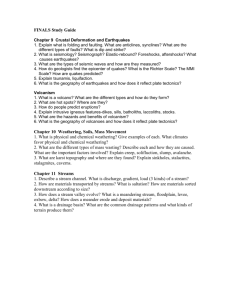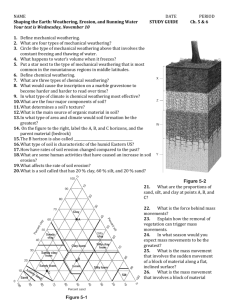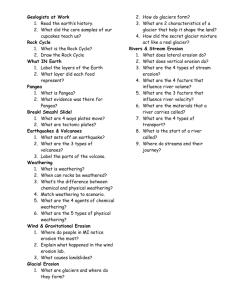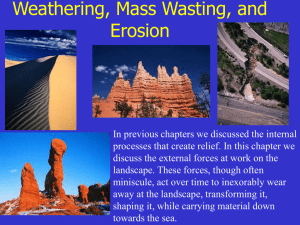Name: Date: Outcome 4: Weathering, Erosion and Deposition How
advertisement
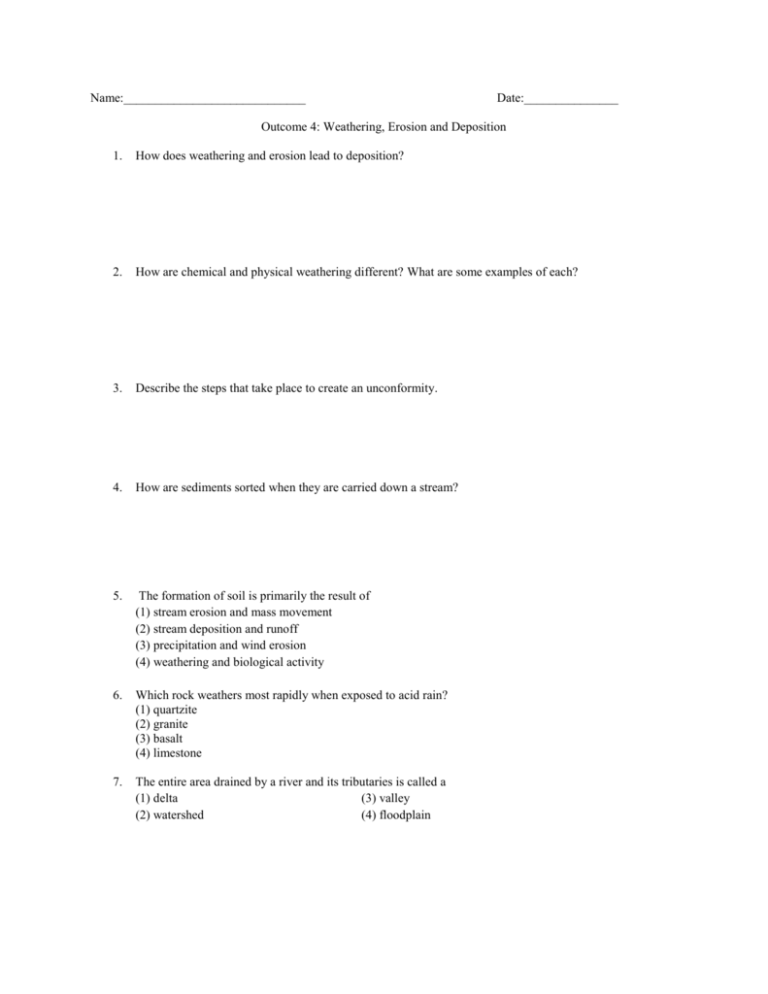
Name:_____________________________ Date:_______________ Outcome 4: Weathering, Erosion and Deposition 1. How does weathering and erosion lead to deposition? 2. How are chemical and physical weathering different? What are some examples of each? 3. Describe the steps that take place to create an unconformity. 4. How are sediments sorted when they are carried down a stream? 5. The formation of soil is primarily the result of (1) stream erosion and mass movement (2) stream deposition and runoff (3) precipitation and wind erosion (4) weathering and biological activity 6. Which rock weathers most rapidly when exposed to acid rain? (1) quartzite (2) granite (3) basalt (4) limestone 7. The entire area drained by a river and its tributaries is called a (1) delta (3) valley (2) watershed (4) floodplain 8. The diagram below shows two identical containers filled with uniform particles that were sorted by size. Which characteristic is most likely the same for these particle-filled containers? (1) infiltration rate (3) capillarity (2) water retention (4) porosity 9. Which soil conditions normally result in the greatest amount of runoff? (1) low permeability and gentle slope (2) low permeability and steep slope (3) high permeability and gentle slope (4) high permeability and steep slope 10. A meandering stream deposits most of its sediments on the (1) inside of meanders where the stream flows faster (2) inside of meanders where the stream flows slower (3) outside of meanders where the stream flows faster (4) outside of meanders where the stream flows slower 11. A soil sample with a large amount of space between the particles will have a (1) low permeability rate (3) high porosity (2) low infiltration rate (4) high capillarity 12. The largest sediment particles that can be transported by a stream traveling at a velocity of 200 centimeters per second are (1) boulders (3) pebbles (2) cobbles (4) sand 13. Soil that contains large quantities of calcium was most likely formed by the weathering of (1) rock salt (3) coal (2) limestone (4) quartzite 14. Which weathering process is most common in a hot, dry environment? (1) Abrasion (2) Carbonation (3) frost action (4) hydrolysis 15.Pieces of bedrock material that are broken from a cliff and deposited by a landslide at the base of the cliff are best described as (1) rounded and sorted (2) rounded and unsorted (3) angular and sorted (4) angular and unsorted 16. The letters A through D in the cross section below represent four of the processes that are part of the water cycle. Which table correctly matches each letter with the process that it represents? 17. The map below shows a meandering stream. Points A, B, C, and D represent locations along the stream bottom. At which location is the greatest amount of sediment most likely being deposited? (1) A (2) B (3) C (4) D 18. New York State’s Catskills are classified as which type of landscape region? (1) mountain (3) lowland (2) plateau (4) plain 19. The photograph below shows a valley. Which agent of erosion most likely produced this valley’s shape? (1) moving ice (2) running water (3) blowing wind (4) ocean waves The diagrams below represent three containers, A, B, and C, which were filled with equal volumes of uniformly sorted plastic beads. Water was poured into each container to determine porosity and infiltration time. 20. Which data table best represents the porosity and infiltration time of the beads in the three containers?
